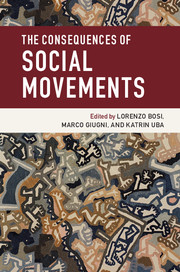Book contents
- Frontmatter
- Contents
- List of figures
- List of tables
- List of contributors
- Introduction
- Part I People
- Part II Policies
- 7 Protest against school closures in Sweden: accepted by politicians?
- 8 Feminist mobilization and the politics of rights
- 9 Reputation, risk, and anti-corporate activism: how social movements influence corporate outcomes
- 10 Tactical competition and movement outcomes on markets: the rise of ethical fashion
- Part III Institutions
- Conclusion
- Index
- References
9 - Reputation, risk, and anti-corporate activism: how social movements influence corporate outcomes
from Part II - Policies
Published online by Cambridge University Press: 05 January 2016
- Frontmatter
- Contents
- List of figures
- List of tables
- List of contributors
- Introduction
- Part I People
- Part II Policies
- 7 Protest against school closures in Sweden: accepted by politicians?
- 8 Feminist mobilization and the politics of rights
- 9 Reputation, risk, and anti-corporate activism: how social movements influence corporate outcomes
- 10 Tactical competition and movement outcomes on markets: the rise of ethical fashion
- Part III Institutions
- Conclusion
- Index
- References
Summary
Changing corporate practices or policies is an incremental, yet key, step for many social movement agendas (for a review, see King and Pearce 2010). Research about the interactions of movements and corporations has risen in popularity in recent years, in part due to purposeful refocusing efforts by prominent scholars in the field (see, for example, Davis et al. 2005). Spurred by Zald's and Berger's (1978) early formulation of organizations as political entities that are often the focus of internal power struggles and mass movements, scholars have begun investigating the ways in which organizations are sites of employee-led movements (e.g., Lounsbury 2001; Raeburn 2004), shareholder activism (e.g., Davis and Thompson 1994; Rao and Sivakumar 1999), and extra-institutional activism by external constituents (e.g., Schurman 2004; King and Soule 2007).
Underlying much of this research is a fundamental theoretical question: why would corporate decision-makers ever concede to activists who are less powerful, have no access to mechanisms of democratic decision-making within those organizations, and who often represent marginal stakeholders? Employee-led movements usually make up a small proportion of all employees and have grievances that are particular to a specific employee group, as for example when gay and lesbian employees sought same-sex domestic partner benefits from their employers (Raeburn 2004; Briscoe and Safford 2008). Shareholder activists usually have concerns that do not reflect the greater interests of the investor public, such as religious investors whose grievances have a moral rather than an economic rationale (Proffitt and Spicer 2006). External movements are usually focused on particular grievances that fall outside the attention of the majority of employees or investors but that have significance to the greater movement's agenda, such as when the anti-genetic engineering movement protested companies for producing genetically modified organisms (Schurman 2004; Schurman and Munro 2009). In all of these cases, the social movements seeking change were led by activist groups that did not have serious resource advantages over their adversaries, that were outnumbered by the mass market of consumers and investors who affiliated with the companies, and had agendas that were likely seen as radical or marginal by the majority of decision-makers within the firm. And yet, in all of the cases mentioned above, activists were able to win significant concessions from their corporate targets.
- Type
- Chapter
- Information
- The Consequences of Social Movements , pp. 215 - 236Publisher: Cambridge University PressPrint publication year: 2016
References
- 13
- Cited by



